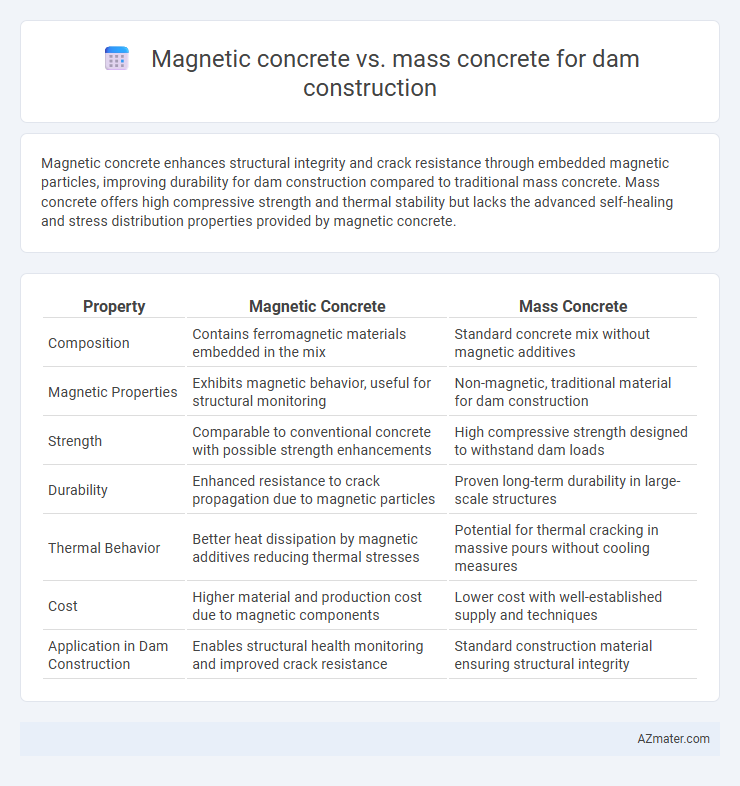Magnetic concrete enhances structural integrity and crack resistance through embedded magnetic particles, improving durability for dam construction compared to traditional mass concrete. Mass concrete offers high compressive strength and thermal stability but lacks the advanced self-healing and stress distribution properties provided by magnetic concrete.
Table of Comparison
| Property | Magnetic Concrete | Mass Concrete |
|---|---|---|
| Composition | Contains ferromagnetic materials embedded in the mix | Standard concrete mix without magnetic additives |
| Magnetic Properties | Exhibits magnetic behavior, useful for structural monitoring | Non-magnetic, traditional material for dam construction |
| Strength | Comparable to conventional concrete with possible strength enhancements | High compressive strength designed to withstand dam loads |
| Durability | Enhanced resistance to crack propagation due to magnetic particles | Proven long-term durability in large-scale structures |
| Thermal Behavior | Better heat dissipation by magnetic additives reducing thermal stresses | Potential for thermal cracking in massive pours without cooling measures |
| Cost | Higher material and production cost due to magnetic components | Lower cost with well-established supply and techniques |
| Application in Dam Construction | Enables structural health monitoring and improved crack resistance | Standard construction material ensuring structural integrity |
Introduction to Magnetic Concrete and Mass Concrete
Magnetic concrete incorporates ferromagnetic materials like iron particles to enhance electromagnetic properties, improving structural monitoring and durability in dam construction. Mass concrete refers to large volumes of concrete poured and cured as a single unit, designed to resist thermal stresses and maintain stability under substantial loads. Both materials are critical in dam engineering, with magnetic concrete offering advanced sensing capabilities and mass concrete providing foundational strength.
Key Properties of Magnetic Concrete
Magnetic concrete exhibits unique properties such as enhanced mechanical strength, improved crack resistance, and electromagnetic interference shielding, making it an innovative alternative to traditional mass concrete in dam construction. Its incorporation of ferromagnetic materials allows for self-sensing capabilities and real-time structural health monitoring, crucial for ensuring dam safety and durability. The high density and magnetic permeability of magnetic concrete also contribute to better load distribution and resistance against seismic forces compared to conventional mass concrete.
Characteristics of Mass Concrete
Mass concrete, typically used in dam construction, is characterized by its large volume and low heat generation during curing, minimizing thermal cracking risks. Its composition includes coarse aggregates, cement, water, and sometimes admixtures to enhance durability and strength. Unlike magnetic concrete, mass concrete does not incorporate magnetic materials or exhibit magnetic properties but focuses on structural stability and longevity under high compressive loads.
Differences in Composition and Materials
Magnetic concrete for dam construction incorporates ferromagnetic materials such as iron particles or steel fibers, enhancing magnetic properties and enabling structural health monitoring through magnetic field detection. Mass concrete primarily relies on conventional aggregates, cement, and water without magnetic additives, emphasizing volume and thermal management to reduce cracking. The inclusion of magnetic materials in magnetic concrete alters its density and durability characteristics compared to mass concrete, impacting the selection of components for specialized dam engineering applications.
Construction Techniques: Magnetic vs Mass Concrete
Magnetic concrete integrates ferromagnetic materials allowing for controlled alignment and enhanced bonding through electromagnetic fields during placement, improving microstructural density and reducing curing time compared to traditional mass concrete. Mass concrete relies on conventional pouring and curing methods, emphasizing thermal control to prevent cracking due to heat of hydration in large volumes. Construction techniques for magnetic concrete involve precise electromagnetic field application equipment, while mass concrete requires robust temperature monitoring and cooling systems to ensure structural integrity.
Structural Performance in Dam Applications
Magnetic concrete enhances structural performance in dam applications by improving tensile strength and resistance to cracking through the alignment of magnetic particles within the matrix, offering superior durability under cyclic loading conditions compared to traditional mass concrete. The integration of magnetic additives reduces microstructural weaknesses, resulting in increased fracture toughness and better energy dissipation during seismic events. Mass concrete, while effective in providing bulk stability, typically exhibits lower tensile capacity and higher susceptibility to thermal cracking due to its homogeneous composition and slower stress redistribution.
Durability and Longevity Comparison
Magnetic concrete incorporates ferromagnetic materials that enhance durability by reducing crack propagation and improving resistance to dynamic loads compared to conventional mass concrete. The improved microstructure of magnetic concrete increases its longevity, making it less susceptible to environmental degradation such as freeze-thaw cycles and chemical attacks. In contrast, traditional mass concrete may suffer from shrinkage and thermal cracking over time, which can compromise dam integrity and require more frequent maintenance.
Environmental Impact and Sustainability
Magnetic concrete utilizes embedded magnetic materials that can reduce carbon emissions by enhancing curing efficiency and decreasing cement usage, promoting sustainability in dam construction. Mass concrete, traditionally reliant on large volumes of Portland cement, contributes significantly to CO2 emissions and has a higher environmental footprint. Incorporating magnetic concrete technologies leads to lower energy consumption and improved durability, aligning with eco-friendly dam infrastructure goals.
Cost Analysis: Initial and Long-Term
Magnetic concrete generally incurs higher initial costs due to the inclusion of specialized magnetic materials and advanced manufacturing processes compared to traditional mass concrete. Long-term expenses for magnetic concrete can be offset by enhanced durability and reduced maintenance requirements, while mass concrete often demands more frequent repairs and monitoring. Cost analysis for dam construction must weigh upfront investment against lifecycle savings, making magnetic concrete a potentially more economical choice despite its initial premium.
Future Trends in Dam Construction with Advanced Concrete Types
Magnetic concrete integrates ferromagnetic materials, enhancing structural health monitoring through electromagnetic sensing, presenting a future trend in dam construction by enabling real-time damage detection and maintenance optimization. Mass concrete, traditionally used for large dam structures due to its high compressive strength and thermal stability, is increasingly being combined with advanced additives to improve durability and reduce thermal cracking. The future of dam construction leans towards smart, composite concretes that incorporate magnetic properties and nanomaterials, offering improved safety, longevity, and environmental sustainability.

Infographic: Magnetic concrete vs Mass concrete for Dam construction
 azmater.com
azmater.com